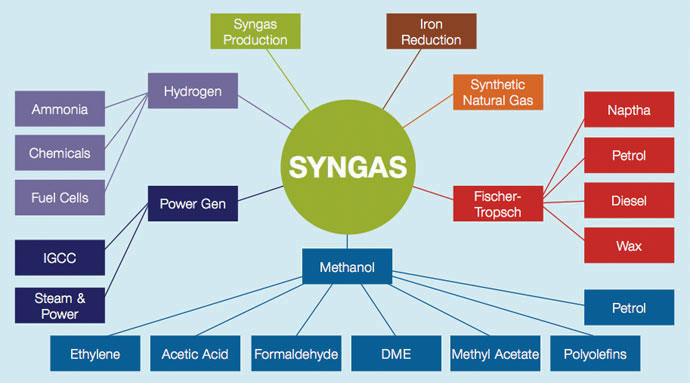Syn-gas: A versatile and renewable fuel
So you may be asking yourself, what is syn-gas? No it is not a bad pun on a 90’s comedian. It is short for Synthesis Gas (also known as Producer Gas) and it is the end product of a gasification system. It has similar properties to natural gas and the key combustible gasses it contains are hydrogen and carbon monoxide. The beauty of syn-gas is it is very versatile and can be used for a multitude of applications. Lets take a look at a few applications you can use with this renewable fuel.
1. Power an internal combustion engine to create electricity: Syn-gas can fuel a modified natural gas or a specialized syn-gas internal combustion engine generator. This creates electricity which can be fed back into the grid or power your business. Another key element to this application is heat capture. Heat can be captured off the generator and/or the gasification system to heat water, dry feedstock or any other heat use a company may have.
2. Processed further to create various fuels: By further processing syn-gas through a method called the Fischer-Tropsch process, syn-gas can be turned into diesel, methane, methanol, and dimethyl ether which all can fuel vehicles.
3. Power a turbine for electricity: If you want a more simplistic application, syn-gas can power a turbine for electricity. The key for a turbine is the gas does not have to be cleaned or cooled. As hot syn-gas expands through the turbine, it spins the rotating blades. The rotating blades perform a dual function: they drive the compressor to draw more pressurized air into the combustion section, and they spin a generator to produce electricity. Heat capture can be added to the system just like an internal combustion system.
4. Power a boiler and/or kiln: In certain circumstances, pre-existing boilers, kilns, dryers and furnaces can be retrofitted to use renewable syngas in place of fossil fuels. Boilers and kilns are often used in everyday industrial applications.
The versatility of syn-gas is one of the reasons Richard Woods, found of Waste to Energy Systems, opted to develop a downdraft gasification system as one of our first products. To learn more about our gasification system, bioHearth®, click here.




